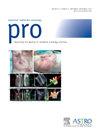表面引导乳腺放射治疗中的牵引运动及其对单一 PTV 边缘策略的影响。
IF 3.4
3区 医学
Q2 ONCOLOGY
引用次数: 0
摘要
背景和目的:本研究量化了乳腺癌体表引导放射治疗(SGRT)中的分射内运动,并考虑了在计算规划靶区(PTV)边缘时对个体化分射内运动测量的需求:方法:使用 SGRT 评估连续患者的分量内运动,根据(1)照射部位(全乳(WB)/胸壁(CW)与 WB/CW + 区域淋巴结)和(2)使用深吸气屏气(DIBH)与自由呼吸(FB)。在整个治疗过程中,对所有病例的牵引运动变化进行了评估。研究还探讨了牵引内运动与患者具体特征之间的关联。研究还考虑了用于确定PTV边缘的个体化牵引内运动测量的实用性:结果:共纳入了102名接受了1360次分割的患者。在总体水平上,平移和旋转方向的平均分段内运动分别小于0.4毫米和0.2度,第95百分位数小于1.2毫米和0.6度。根据照射部位或使用DIBH的不同,没有观察到有临床意义的分段内运动差异。在整个治疗过程中,所有患者的分段内运动均保持一致。分段内运动与患者的具体特征(如年龄、血清肿体积、PTV体积和平均体量)之间没有发现有临床意义的关联:结论:使用制造商推荐的 ROI 进行 SGRT 治疗时,点内偏差极小,不会因不同的治疗技术或患者的具体特征而发生重大变化,并且在整个治疗过程中保持不变。通用的点内运动测量方法可能足以计算 PTV 边界。还需要进一步的验证研究来评估 ROI 大小和覆盖范围的影响。本文章由计算机程序翻译,如有差异,请以英文原文为准。
Intrafraction Motion in Surface-Guided Breast Radiation Therapy and its Implications on a Single Planning Target Volume Margin Strategy
Purpose
This study quantifies intrafraction motion in surface-guided radiation therapy (SGRT) for breast cancer and considers the need for individualized intrafraction motion measures when calculating planning target volume (PTV) margins.
Methods and Materials
SGRT was used to assess intrafraction motion in consecutive patients according to (1) site irradiated (whole-breast/chest wall vs whole-breast/chest wall + regional lymph nodes) and (2) the use of deep inspiration breath hold versus free breathing. Intrafraction motion variation was evaluated throughout the treatment course for all cases. Associations between intrafraction motion and patient-specific characteristics were explored. The usefulness of individualized intrafraction motion measures for PTV margin determination was considered.
Results
One hundred two patients undergoing 1360 fractions were included. On a population level, average intrafraction motion was less than 0.4 mm and 0.2 degrees for translational and rotational directions, respectively, with 95th percentiles <1.2 mm and 0.6 degrees, respectively. No clinically meaningful differences in intrafraction motion were observed according to the site irradiated or the use of deep inspiration breath hold. Consistency in intrafraction motion was noted for all patients throughout the treatment course. No clinically meaningful associations were found between intrafraction motion and patient-specific characteristics such as age, seroma volume, PTV volume, and mean body volume.
Conclusions
Intrafractional deviations with SGRT, using manufacturer-recommended regions of interest, are minimal, do not vary substantially for different treatment techniques or patient-specific characteristics, and remain constant throughout the treatment course. A universal intrafraction motion measure may be sufficient for calculating PTV margins. Further validation studies are needed to evaluate the impact of region of interest size and coverage.
求助全文
通过发布文献求助,成功后即可免费获取论文全文。
去求助
来源期刊

Practical Radiation Oncology
Medicine-Radiology, Nuclear Medicine and Imaging
CiteScore
5.20
自引率
6.10%
发文量
177
审稿时长
34 days
期刊介绍:
The overarching mission of Practical Radiation Oncology is to improve the quality of radiation oncology practice. PRO''s purpose is to document the state of current practice, providing background for those in training and continuing education for practitioners, through discussion and illustration of new techniques, evaluation of current practices, and publication of case reports. PRO strives to provide its readers content that emphasizes knowledge "with a purpose." The content of PRO includes:
Original articles focusing on patient safety, quality measurement, or quality improvement initiatives
Original articles focusing on imaging, contouring, target delineation, simulation, treatment planning, immobilization, organ motion, and other practical issues
ASTRO guidelines, position papers, and consensus statements
Essays that highlight enriching personal experiences in caring for cancer patients and their families.
 求助内容:
求助内容: 应助结果提醒方式:
应助结果提醒方式:


